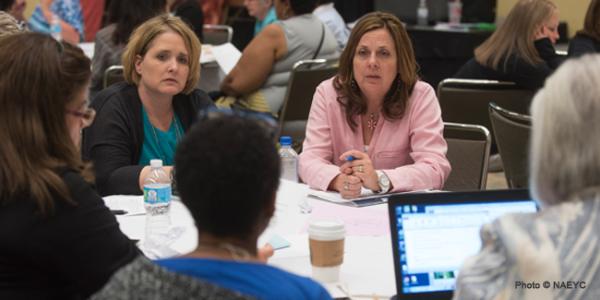Returning to Teaching—Empowered by PDI

As a first-time institute attendee, I did not know what to expect at NAEYC’s 2016 National Institute for Early Childhood Professional Development (PDI), June 5–8, in Baltimore. I left this year’s PDI feeling empowered. I left with the tools necessary to help make the future of early childhood education (ECE) brighter—in my own corner as well as in the larger society.
Let’s backtrack a little. I started my career in ECE a decade ago, while also working on my MFA in creative writing. A few years ago, I decided to take some time away from the field to write professionally and teach as a college writing instructor. As 2016 approached, I started to miss teaching young children. More important, the movement to professionalize the ECE field was palpable, and I wanted to be a part of it. January 2016 was a big month for me: I returned to the field as an assistant pre-K teacher and enrolled in Champlain College’s low-residency MEd program in early childhood education. Attending PDI fulfills the program’s residency requirement.
During PDI, I met my Champlain cohort for the first time at the Pratt Street Ale House, our designated meeting spot. The warm presence of the program director and my classmates quickly soothed any nerves I had. As we immersed ourselves in discussion about the PDI experience, I was reminded that ECE professionals are among our nation’s smartest, most innovative workers.
The best part of PDI is that the sessions are as applicable as they are informative. Here are my top three takeaways:
Loose parts play promotes open-ended learning. In a panel session on the play experience, I learned for the first time about the advantages of loose parts play. Using random materials, we engaged in solo and cooperative play. For most, this experience was calm and focusing. Loose parts play allows children to imagine, create, explore, and problem solve, and we felt this firsthand at PDI.
For more information on loose parts play, see this article and video entitled "Look Again!" from Teaching Young Children.
Make technology experiences interactive. The latest research on children and screens explains that the screens themselves aren’t bad, it’s what we do with them. In a session about their book Tap, Click, Read: Readers in a World of Screens, Lisa Guernsey and Michael Levine explained that many apps have features that can be advantageous to children’s learning. It is important to look for apps that have interactive features like narration and dynamic visuals. Most important, technology truly supports children’s learning when adults are there to play along with them.
Lisa Guernsey and Michael Levine’s recent article in Young Children, “Getting Smarter About E-Books for Young Children” offers more ideas from their book.
Families want to understand play. Laurel Bongiorno, Champlain College’s Division Dean of Education and Human Studies, explained that families often share educators’ beliefs about the benefits of play but need more information to support this understanding. Laurel recommended explaining child development terms like cognitive development and symbolic play to parents and other family members and giving them pictures that demonstrate each. When we help families understand the language of child development, they are better able to see that play is learning.
Interested in helping the families of children in your program understand play? See this model memo on the value of play from NAEYC’s book Spotlight on Young Children: Exploring Play. Another great idea would be to direct family members to Lisa Guernsey's article, "10 Things Every Parent Should Know About Play," on NAEYC's For Families site.
I can’t wait for next year’s PDI!
Teresa Narey is a prekindergarten teacher at Beth Shalom Early Learning Center in Pittsburgh, Pennsylvania, and a student in Champlain College’s low-residency graduate program in early childhood education.